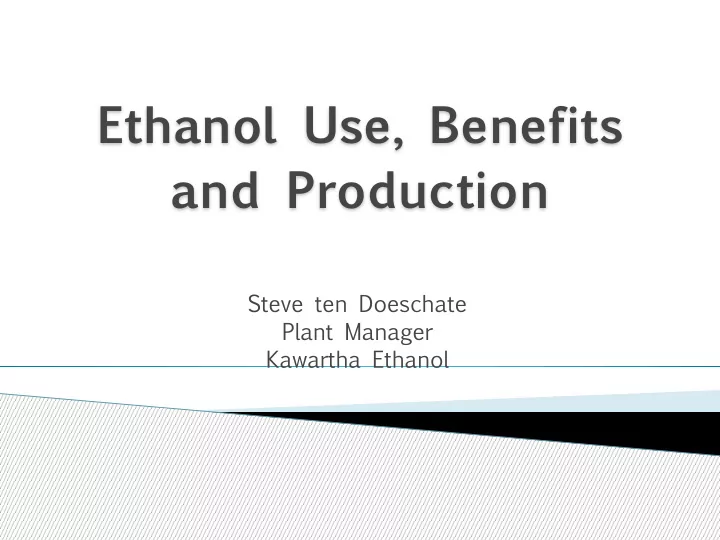

Ethanol Use, Benefits and Production Steve ten Doeschate Plant Manager Kawartha Ethanol
What is Ethanol � Ethanol is a renewable, clean-burning, high octane motor fuel. � � This liquid alcohol is made up of oxygen, hydrogen and carbon and is obtained from the fermentation of sugar or converted starch contained in grains and other agricultural or agri-forest feedstocks.
Environmental Benefits Ethanol cuts emissions from our cars. Ethanol reduces tailpipe carbon monoxide emissions by as � much as 30%, toxic content by 13% (mass) and 21% (potency) and tailpipe fine particulate matter emissions by 50%. Ethanol lowers GHG’s by up to 62% � The 5% RFS alone will generate 4.2Mts fewer emissions – or the equivalent of removing one million � cars from our nation’s highways. Ethanol replaces carcinogens in your fuel. Ethanol actually cuts down cancer-causing emissions such � as benzene from our fuel. Ethanol is an oxygenate, a fuel additive that raises the octane level of gasoline, producing a motor fuel that burns more cleanly. For example, a study by the Colorado Division of Public Health and the Environment (DPHE) study showed E10 reduced hydrocarbon pollution like benzene by 16.5%. The most reliable third party studies show that ethanol clearly has a positive energy balance. For one � example, the USDA states a value of 1.34. Ethanol cuts smog. Studies show that ethanol reduces particulate matter by up to 50%, reduces � tailpipe emissions by as much as 30% and reduces toxic emissions by 30%. No harm to water. A study conducted for the Governors' Ethanol Coalition, "The Fate and Transport � of Ethanol-Blended Gasoline in the Environment," concluded that ethanol poses no threat to surface water and ground water.
Ethanol Usage � The RFS in Canada ensures 5% ethanol (renewable content) in gasoline began December 15, 2010 � � Almost 1.8 Billion litres of ethanol produced annually in Canada
Kawartha Ethanol Inc. ◦ Grand opening March 27 th , 2010 ◦ Operated at 100% July, 2010 ◦ 24/7 Operation ◦ Highly automated ◦ Employees: 30 ◦ 2 operators per shift
“Nameplate”- Design Capability � 80 million L per year design � � 100 million L per year currently � 8,333,333 litres per month � 285,714 litres per day � 11,905 litres per hour � 198 litres per minute
Corn Usage � Operating our current rate of 100,000,000 litres per year the plant will use the following tonnes (T)/ bushels (bu) of corn: � ◦ 246,914 T or 9,720,510 bu per year ◦ 20,576 T or 810,036 bu per month ◦ 705 T or 27,754 bu per day ◦ 29 T or 1,141 bu per hour ◦ 0.49 T or 19 bu per minute
Corn Grading
Corn Receiving
Grain Storage
Hammermills
Control Room
Mashing and Liquifaction
Fermentation
Quality Assurance Lab
Distillation, Dehydration and Evaporation
Distillation Columns
Evaporators
Ethanol Storage & Truck Loading
Centrifuges
Wet Distillers Grains with Soluables
Advantages to Wet Distillers Grains � Palatability, cows love eating it! � � Mid level protein similar to soy meal � � Competitively priced against soy meal � � Contain by-pass protein which is digested in later stomachs for better milk production
Corn Oil Extraction Process
Corn Oil Storage
Corn Oil � Can by used as animal feed additive � Primarily for biodiesel production � Producing approximately 0.5 lbs / bushel
Boilers
Water Source for Plant
Issues for Ethanol into the Future
US Renewable Fuel Standard
Access to Higher Ethanol Blends � Very limited gas stations offering blends above 10% � � Oct 16 th Gales Gas Bars started offering E30, the first station to in the Niagara region
Cellulosic Ethanol � Is ethanol made from cellulose, a non-grain material that provides the cellular structure for all plants. � � Cellulose is the world's most abundant organic compound. � � Challenge is breaking it down to glucose
Questions?
Recommend
More recommend